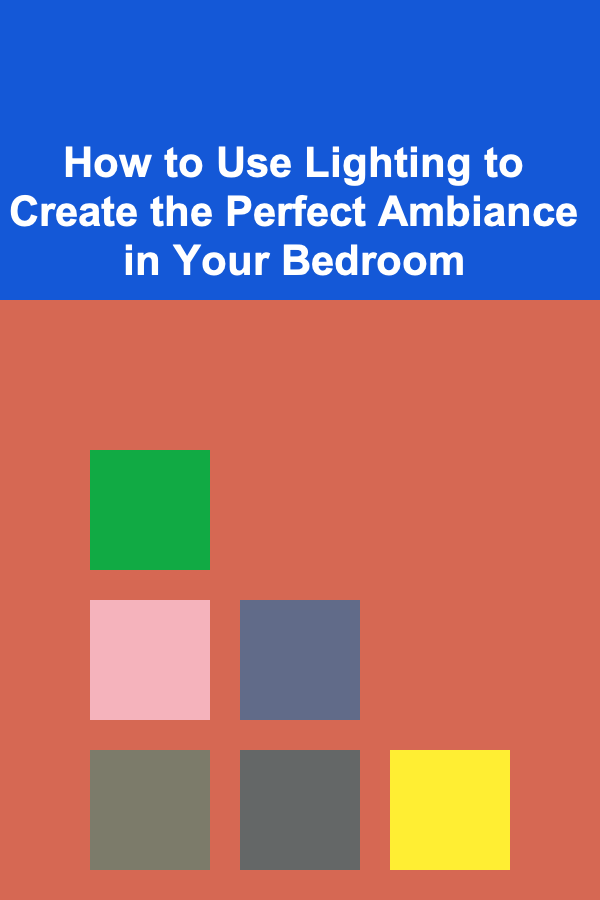
How to Use Lighting to Create the Perfect Ambiance in Your Bedroom
ebook include PDF & Audio bundle (Micro Guide)
$12.99$8.99
Limited Time Offer! Order within the next:

Lighting plays a pivotal role in setting the mood of any room in a home, but when it comes to the bedroom, the right lighting can completely transform the space. Bedrooms are where we unwind, rest, and rejuvenate, and the ambiance within this space is essential for creating the right atmosphere for relaxation, intimacy, or productivity. In this article, we will explore the different ways lighting can be used to craft the perfect ambiance in your bedroom, taking into account the interplay of natural and artificial light, the types of lighting fixtures, and the strategic placement of light sources.
The Psychology of Lighting and Its Effect on Mood
Before diving into the specific techniques and tips for using lighting in the bedroom, it's important to first understand how lighting affects our emotions, behavior, and mood. Light has a profound impact on our well-being and can either calm and soothe or energize and stimulate, depending on its intensity, color, and distribution.
How Light Affects Our Mood
- Warm Light vs. Cool Light: The color temperature of light significantly influences the atmosphere of a space. Warm light, which is typically yellow or amber in hue, evokes feelings of warmth, comfort, and relaxation. On the other hand, cool light, with a bluish tint, is more energizing and can help create a more focused and alert environment. For a bedroom, warm light is generally preferred because it encourages relaxation and restful sleep.
- Bright vs. Dim Lighting: Intensity of light is another critical factor in creating the right ambiance. Bright, harsh lighting can make a space feel sterile, energetic, and uncomfortable. On the contrary, dim lighting can create a sense of coziness, intimacy, and relaxation, ideal for unwinding after a long day. Adjustable lighting allows you to control the mood based on the time of day or activity.
- Lighting and Sleep: Exposure to certain types of light---particularly blue light---can interfere with sleep patterns. The bedroom is a space where the need for restorative sleep is paramount. Therefore, lighting choices that promote relaxation and minimize stimulation are crucial.
By understanding the psychological effects of light, you can begin to select lighting elements that align with the desired mood of your bedroom.
Types of Lighting to Consider for Your Bedroom
When it comes to lighting your bedroom, there are three main types of lighting to consider: ambient, task, and accent lighting. Each type serves a distinct purpose, and when combined, they can work together to achieve the ideal lighting setup for your bedroom. By thoughtfully layering these types of light, you can create a dynamic and adaptable lighting scheme.
1. Ambient Lighting: General Illumination
Ambient lighting, also known as general lighting, provides the overall illumination in a room. It sets the base level of light for the entire space and ensures that you can move around safely. While ambient lighting is essential for functionality, it can also play a key role in creating the right mood. In the bedroom, ambient lighting should be soft, diffused, and calming.
Best Ambient Lighting Options for the Bedroom
- Ceiling Lights: A central ceiling light can serve as the primary source of ambient light. For a bedroom, consider installing a dimmable fixture that allows you to adjust the brightness according to your needs. Chandeliers, pendant lights, and modern flush-mount ceiling lights can all provide stylish and even illumination. Choose a fixture that complements your bedroom's décor style.
- Recessed Lighting: Recessed or downlights installed in the ceiling provide a sleek and modern look. They offer a subtle, unobtrusive form of ambient lighting that doesn't overpower the room, making them ideal for a bedroom where a calm atmosphere is key.
- Wall-Mounted Lighting: Wall-mounted light fixtures, such as sconces or wall lamps, can offer both ambient and accent lighting. When placed on either side of the bed, they provide soft, even illumination while also saving space on nightstands.
2. Task Lighting: Focused Illumination for Specific Activities
Task lighting is focused lighting designed to help with specific activities such as reading, writing, or getting dressed. In the bedroom, task lighting can be used to enhance comfort and functionality without overwhelming the space with too much light.
Best Task Lighting Options for the Bedroom
- Bedside Lamps: Bedside lamps are perfect for reading in bed or adding a touch of warmth to your bedroom decor. Choose lamps with adjustable arms or swivels, so you can direct the light precisely where you need it. Opt for soft, warm-colored bulbs to ensure that the light doesn't become too harsh for the eyes.
- Desk or Vanity Lights: If your bedroom doubles as a workspace, desk lamps with adjustable brightness are an excellent way to illuminate your work area. Similarly, vanity lighting can help illuminate your reflection for tasks like grooming or applying makeup. Avoid overhead lights that can cast unflattering shadows and instead use diffused light sources at eye level.
- Under-Bed or Under-Shelf Lighting: For added convenience, consider installing LED strips under your bed frame or shelves. These can serve as task lighting when you need to find something in your drawers or organize your belongings.
3. Accent Lighting: Adding Depth and Visual Interest
Accent lighting is designed to highlight specific features of the room, such as artwork, architectural details, or decorative elements. It can be used to create focal points, add visual depth, and set a more intimate or dramatic atmosphere. Accent lighting should be used sparingly to avoid overwhelming the space.
Best Accent Lighting Options for the Bedroom
- Track Lighting: Track lighting is versatile and allows you to direct light to specific areas or objects in the room. You can use track lighting to highlight artwork, wall textures, or architectural details, such as built-in shelves or headboards.
- Table Lamps with Unique Designs: If your bedroom has a statement piece like a decorative table lamp, it can act as both functional and accent lighting. Positioning these lamps in strategic locations, such as next to a bed or on a side table, can add visual interest.
- Fairy Lights or String Lights: For a whimsical and romantic ambiance, consider draping fairy lights or string lights along the headboard, walls, or ceiling. These can create a soft, dreamy glow and give your bedroom a cozy, intimate feel.
- Spotlights and Directional Lamps: These can be used to draw attention to a piece of artwork, a favorite decorative object, or a feature wall. Positioning accent lighting in a way that draws focus can significantly enhance the design of the room.
Strategic Placement of Lighting in the Bedroom
While selecting the right type of lighting is important, the placement of your light sources is equally critical. In order to create the perfect ambiance, it is essential to position your lighting in a way that complements the room's layout, size, and function.
1. Positioning Lights Near the Bed
The bed is the focal point of the bedroom, and the lighting around it should be both functional and atmospheric. Bedside lamps or wall sconces placed on either side of the bed provide soft, ambient light that can be adjusted for reading or relaxation. Consider adding a dimmer switch to control the intensity of the light.
2. Layering Light for Depth
Layering is the practice of combining ambient, task, and accent lighting in such a way that the room feels balanced and dynamic. For example, you can use recessed lighting for general illumination, add a couple of task lights near the bed or desk, and incorporate accent lighting to highlight architectural details or decorative pieces. When the light layers blend seamlessly, the result is a bedroom with rich texture and depth.
3. Emphasizing Vertical Space
To make your bedroom feel taller and more spacious, position lighting higher on the walls or ceiling. This could mean installing sconces or pendant lights that shine upward, or using recessed lighting in the ceiling to distribute light evenly and create an illusion of height. Vertical lighting can help elongate the walls and enhance the overall sense of space in the room.
4. Create a Cozy Atmosphere with Soft Lighting
In the bedroom, harsh, direct lighting is typically not ideal. Soft, indirect light creates a more relaxing and inviting ambiance. Consider using light fixtures with diffusers, such as frosted glass lamps or soft fabric shades, to ensure that the light is evenly dispersed and not overly harsh. You can also use light bulbs with lower wattages to create a gentle, warm glow throughout the room.
Color Temperature and Its Impact on Ambiance
Color temperature refers to the warmth or coolness of light. It is measured in Kelvins (K), with lower numbers indicating warmer, more yellow tones and higher numbers indicating cooler, bluer tones. The color temperature of your lighting can significantly impact the mood of your bedroom.
- Warm White (2700K -- 3000K): Ideal for creating a cozy, intimate, and relaxing atmosphere. This color temperature is perfect for the bedroom because it mimics the glow of natural sunset light, making it ideal for winding down before bed.
- Cool White (3500K -- 4100K): This color temperature has a more neutral or slightly blue tone. It can provide a bright, clean light suitable for tasks such as reading or getting dressed, but it may feel too stimulating for winding down.
- Daylight (5000K -- 6500K): Daylight bulbs are often too intense for a bedroom, as their cool, bluish tone can feel harsh and disrupt the ability to relax. However, they can be useful in a workspace area within a bedroom.
For the perfect bedroom ambiance, focus on warmer color temperatures in your ambient and task lighting, reserving cooler temperatures for specific functional areas like desks or vanity areas.
Conclusion
Creating the perfect ambiance in your bedroom is all about finding the right balance of lighting types, placements, and color temperatures. Whether you are looking for a cozy, intimate atmosphere to wind down after a busy day, or a functional, bright space for morning tasks, lighting is an essential element of your bedroom design. By using a combination of ambient, task, and accent lighting, and paying attention to the psychological effects of light, you can transform your bedroom into a peaceful sanctuary that aligns with your personal style and needs. The right lighting can turn a bedroom from merely a place to sleep into a space that enhances your mood, promotes relaxation, and provides an overall sense of well-being.
Reading More From Our Other Websites
- [Organization Tip 101] How to Stage a Home for Different Seasons
- [Gardening 101] Protecting Perennials: DIY Insulation Techniques for a Frost‑Hardy Garden
- [Organization Tip 101] How to Create a Family Laundry Schedule
- [Organization Tip 101] How to Set Up a Personal Library at Home
- [Personal Finance Management 101] How to Choose the Best Budgeting Software for Your Financial Needs
- [Organization Tip 101] How to Keep Project Instructions and Ideas Organized
- [Home Holiday Decoration 101] How to Incorporate Seasonal Plants into Your Holiday Decorations
- [Organization Tip 101] How to Choose the Right Wallpaper Removal Steamer for Your Needs
- [Personal Investment 101] How to Use Asset Allocation to Optimize Your Investment Portfolio
- [Personal Finance Management 101] How to Prepare for an Economic Downturn and Protect Your Finances

How To Draw Self-Portraits with Confidence
Read More
How to Screen Tenants Using Online Tools and Platforms
Read More
Optimizing Operations: Strategies and Best Practices for an Operations Manager
Read More
How to Master Straddles and Strangles: Advanced Options Strategies for Traders
Read More
Essential Photoshop: A Step-by-Step Workflow
Read More10 Tips for Automating Your Mortgage Interest Expense Tracking
Read MoreOther Products

How To Draw Self-Portraits with Confidence
Read More
How to Screen Tenants Using Online Tools and Platforms
Read More
Optimizing Operations: Strategies and Best Practices for an Operations Manager
Read More
How to Master Straddles and Strangles: Advanced Options Strategies for Traders
Read More